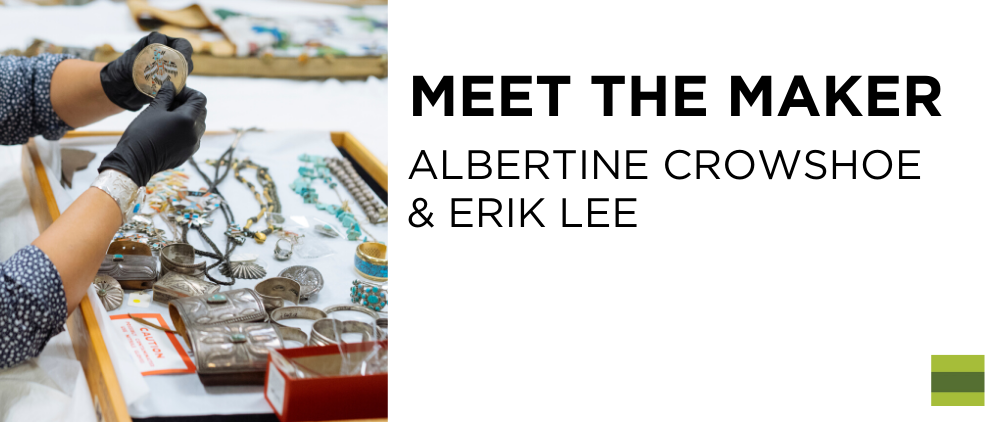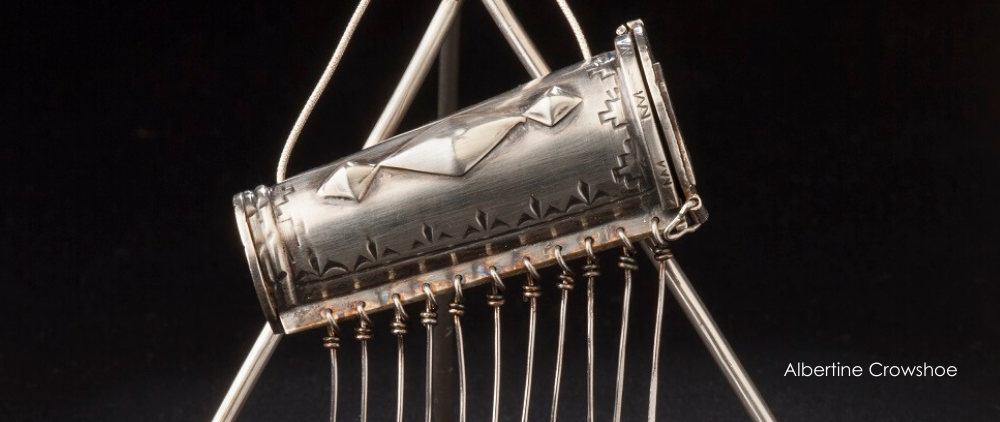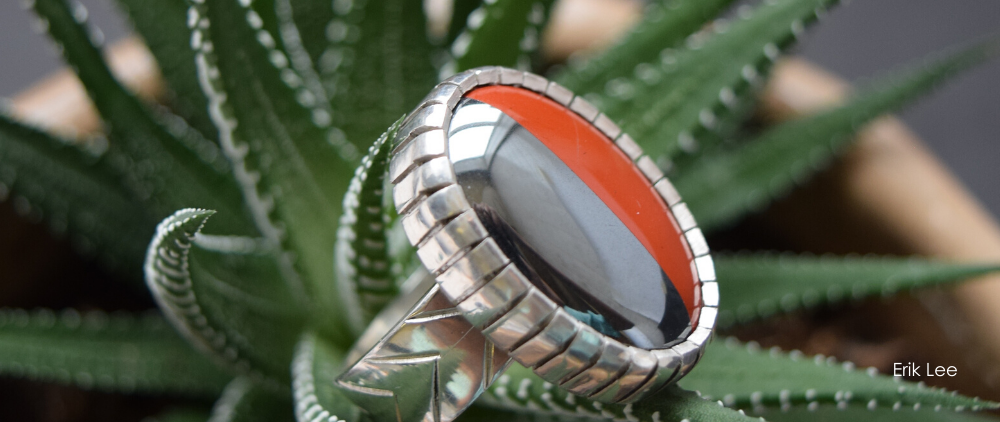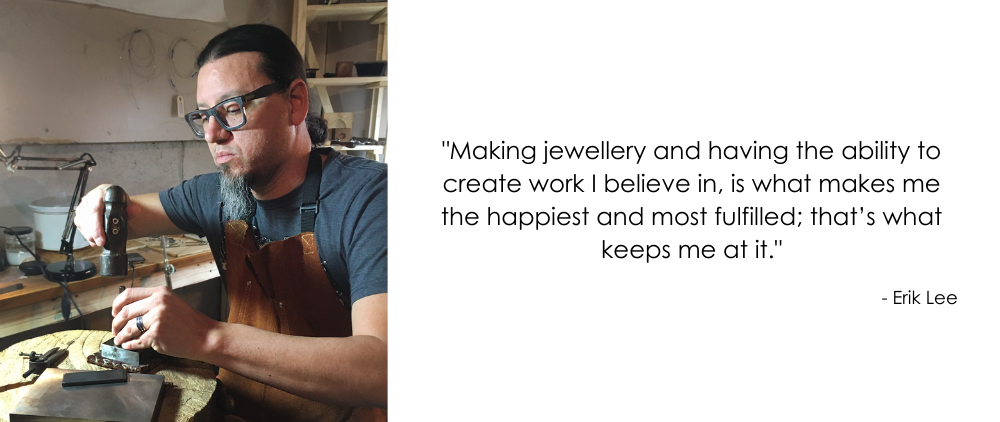Meet the Maker - Albertine Crowshoe & Erik Lee

Albertine Crow Shoe (Piikani Nation) considers her art to be a bridge that connects traditional Blackfoot culture to today’s modern non-Native world. Blackfoot culture is a rich and spiritual world that she interprets through the art of jewellery making. Residing in Maskwacis, Erik Lee specializes in engraved silver, bezel set buffalo horn, moose antler and semi precious stones. Erik’s designs incorporate indigenous Plains Cree motifs in a unique contemporary style.
In the winter issue of Alberta Craft Magazine Corinne Cowell had a chat with Albertine Crowshoe and Erik Lee about their road to becoming jewellers, their successes, their perserverance, and the people that have contributed to them making a career in craft.
Corinne Cowell, Alberta Craft Council: How long have you been a fine craft artist and how did you get started?
Albertine Crow Shoe: I’ve been a fine craft artist for over 25 years. In 2007
I took my first class in jewellery and metals. I had a passion for making but I didn’t know anything about becoming a jeweller so I began with non-credit classes at AUArts. I also took other classes/training in Emporia, KA, Taos, NM, Scottsdale, AZ and Gallup, NM where I met many great teachers. I also wanted to be self-sufficient and generate my own income. In 2016, I began working as a full-time silversmith.
I’m from the Piikani Nation in southern Alberta. We are known for our beautiful beadwork, quill work, work with raw hide, and the list goes on. These art forms created by Niitsitapi (Blackfoot term meaning “Real People”) are exquisite. Today, I am a part of an evolving culture of Indigenous silversmiths in Alberta. Like anything else learning takes time, it’s discovery and exploration, and hands on experience.
Erik Lee: I started making silver jewellery about ten years ago. Prior to that I sculpted stone, antler, wood and worked in many other Cree art forms such as hide tanning, tool making and beadwork. I’m also trained as a graphic designer, all these skills helped. The jewellery started when I lived on Vancouver Island. I was carving wood with Coastal First Nation artists, one of the artists, named Jackson Robertson from Kingcome Inlet, was hand engraving silver. I thought it was amazing so I asked him to teach me. He said, “I can’t really teach you but sit and watch me for a while and then you give it try.”

CC: What was your first big career moment?
AC: In 2013, I did my first show at AUArts, Tradition and Beauty, organized by Charles Lewton-Brain from the Jewellery + Metals department. It was there that the Glenbow Museum bought one of my pieces for their permanent collection. That raised my confidence and was my first of many big moments.
EL: Some of the recent moments have been exhibiting at the Santa Fe Indian Market which is the largest and most prestigious juried Indigenous art event in North America and the Smithsonian Institutes’ National Museum of the American Indian in Washington DC. Those were big for me.
CC: Who are your main supporters?
AC: I have to acknowledge my late husband Paul Raczka, for seeing my creative ability and encouraging me to pursue it. He introduced me to the art world and taught me firsthand about business. Without him, I wouldn’t be a jeweller today.
My family also supported my decision, but I don’t think they fully understood what I was doing until they started to see my work. They bought my pieces and encouraged me to continue. I’ve had many teachers and mentors along the way, they gave me the capacity to grow as a jeweller/artist. But not everyone else was supportive, mainly because they didn’t understand what I did as a silversmith.
EL: My spouse and family have been great sources of encouragement and certain master jewellers from other tribes have been very helpful, providing technical teachings and advice along the way.

CC: What are some highlights from your career? Personally, professionally, creatively?
AC: I am very proud to have my pieces in the Glenbow Museum and the Royal Alberta Museum collections. These are my early pieces and my work has evolved since then. While I was the Artist in Residence at the Glenbow Museum and I was able to help create an exhibition from their Blackfoot collection along with pieces that I fabricated. The Santa Fe Indian Market in Santa Fe, NM brings Native Art to the world by inspiring artistic excellence, fostering education, and creating meaningful partnerships. I am the first Blackfoot female from Alberta to be accepted into this juried show as a jeweller/artist. Silversmithing is fairly new amongst the First Nations people in Alberta and I am only one of a handful of professional jewellers.
EL: Whenever I’m able to travel to exhibit or train is an adventure, I love seeing new places, experiencing other cultures and meeting new people. Creatively, there have been definite breakthroughs. Learning new and sometimes very technically complicated methods of fabrication or production has really unlocked design potential and creative avenues. It’s like levelling up. I’d have to say learning chasing and repoussé and how to do large overlay silver pieces are highlights.

CC: Did you ever have any misgivings? Think about quitting?
AC: A couple of years ago I was at a crossroads between going back to my previous work or to continue as a jeweller. I received a timely call from the Glenbow offering me the Artist in Residence position. That was my saving grace. There are times when I feel like quitting but I remember everything I’ve given up and the sacrifices I’ve made to get to where I am today.
EL: If you aren’t a little bit scared all the time then you aren’t taking the right risks. I think every artist goes through periods of self doubt followed by extreme confidence, or maybe that’s just me? Maybe an artist doubts themselves when they feel like they aren’t being recognized by the right institutions or not getting a nod from someone you respect. I guess that’s the time to just lean on the confidence lever and believe in your own ability and vision. There have been periods of interrupted work, especially when relocating and having to set up a new studio or at a dry time when it seems like the money’s stretched too thin. In the past I’ve had to rely on my graphic design business and take other jobs to support my passion. Making jewellery and having the ability to create work I believe in is what makes me the happiest and most fulfilled; that’s what keeps me at it.
CC: Thoughts/experiences to share with other craft artists?
AC: If you find your true passion and know this is what you want to do, just do it. Trust your abilities and work hard. Know that there will be good shows and bad shows.
EL: Do what you feel creatively. Follow your heart and instincts in your work. Be disciplined (that’s a real challenge) especially when it seems like you are not really getting ahead. Learn from others, ask a million questions, study your craft. Try to hang around with artists you admire and pick their brains, do apprenticeships if you can. Even try and study under masters in other parts of the world. There’s so much to learn. Never stop learning and always push yourself to evolve the work.

CC: What is the hardest part of making a career in craft?
AC: It’s persevering through the hard times. You need to pick yourself up and believe in yourself and your work. You will get rejected but that will make you want to work harder. You must challenge yourself and work hard to see the end results.
EL: That there is no handbook. There’s no step by step you can follow. I think the hardest part is really the admin side of it, doing applications, proposals, and budgets, and explaining yourself over and over to people on paper. That’s not my favourite thing. You don’t think of a career in the arts as heavy in paperwork, but it actually is. The design and creating is the fun part.
CC: Would you do it all again?
AC: I believe in living your life with no regrets. Life is short and it can all change on a dime. I took my first class in jewellery and metals when I was in my late 40s. I knew my decision to become a full-time jeweller/artist would mean leaving my job and a guaranteed income but it has been worth it. I have been very fortunate to meet some very talented jewellers who have become close friends and family. I have been humbled by my experiences. Someone asked me once, if I should have started this when I was younger. I disagreed, I bring with me my life experiences – it wouldn’t be the same if I started earlier in my life as a jeweller because I wouldn’t have the knowledge I have today, that is expressed through my work.
EL: Absolutely.
